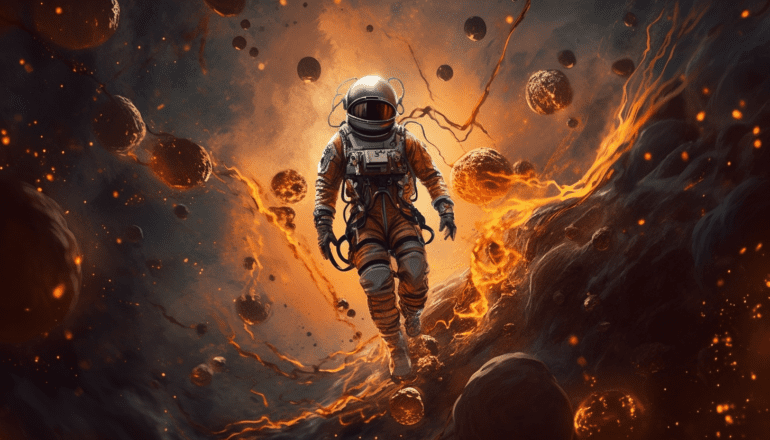TL;DR:
- Researchers from ESA, Columbia, and ANU used AI to generate scientific hypotheses in the field of Galactic Astronomy.
- They leveraged an advanced API called Langchain, allowing manipulation of GPT-4.
- Over 1,000 scientific articles were fed into GPT-4 to enhance its subject knowledge.
- The number of papers accessed affected the quality of the hypotheses generated.
- Experts assessed the hypotheses based on originality, testability, and scientific accuracy.
- Astro-GPT performed at near-expert level, even with a limited dataset.
- Adversarial prompting refined the hypotheses and improved logical coherence.
- LLMs like GPT-4 have untapped potential in idea generation and testing.
Main AI News:
The omnipresence of articles on artificial intelligence (AI) seems unavoidable across the vast expanse of the internet. At the University of Texas (UT), we have also contributed our fair share to this discourse. Typically, these articles highlight how research groups utilize AI to decipher copious amounts of data. However, AI’s prowess extends far beyond pattern recognition. In fact, it is steadily evolving into a platform for abstract thinking. One area where abstract thought can be a valuable asset is in the formulation of new scientific theories. Keeping this in mind, a team of researchers hailing from the European Space Agency (ESA), Columbia University, and the Australian National University (ANU) enlisted the aid of AI to generate scientific hypotheses within the realm of astronomy.
Their focus was primarily on the sub-field of “Galactic Astronomy,” which delves into the intricacies of galaxy formation and physics. The researchers justified their selection by emphasizing the sub-field’s “integrative nature,” necessitating a synthesis of knowledge from diverse domains. Unquestionably, this aligns precisely with AI’s existing capabilities. However, a conventional Large Language Model (LLM) such as ChatGPT or Bard would lack the requisite subject-specific expertise to generate plausible hypotheses in this particular field. There would even be the risk of succumbing to the “hallucinations” that some researchers and journalists caution against when interacting with such models.
To circumvent these limitations, Ioana Ciuc? and Yuan-Sen Ting from ANU, at the helm of this research endeavor, employed a Python-based code called Langchain, which functions as an application programming interface (API). This API allows advanced users to manipulate LLMs like GPT-4, which serves as the foundation for ChatGPT’s latest iteration. In this case, the researchers infused GPT-4 with knowledge from over 1,000 scientific articles pertaining to Galactic Astronomy, sourced from NASA’s Astrophysics Data System.
In one of their experiments, the researchers sought to gauge how the model’s exposure to varying numbers of papers affected the quality of its hypotheses. Notably, a substantial discrepancy emerged between the hypotheses generated with access to merely ten papers versus the complete dataset of one thousand.
Evaluating the hypotheses’ validity posed an intriguing challenge. To surmount it, the researchers resorted to a time-honored scientific approach—they enlisted the expertise of specialists in the field. Precisely two experts were recruited for this task, who assessed the hypotheses based on originality of thought, testability, and scientific accuracy. Astonishingly, even when armed with a modest dataset of only ten papers, the hypotheses suggested by their model, aptly named “Astro-GPT,” garnered ratings slightly below those of a competent Ph.D. student. With access to the full corpus of 1,000 papers, Astro-GPT performed at a “near-expert level.”
The researchers incorporated a crucial element in refining the final hypotheses presented to the experts—namely, “adversarial prompting.” While this might sound confrontational, it simply refers to employing an additional program trained on the same dataset to provide feedback to the hypothesis-generating program. This feedback loop compelled the initial program to rectify any logical fallacies and cultivate superior ideas.
Even with the integration of adversarial feedback, aspiring astronomy Ph.D. students need not relinquish their pursuit of distinctive ideas within their field. However, this study does illuminate an underutilized capability of LLMs. As their adoption continues to expand, scientists and enthusiasts alike can increasingly harness their potential to conceive novel ideas and enhance testing methodologies.
Conclusion:
This research demonstrates the significant strides made in leveraging AI for hypothesis generation in astronomy, specifically in Galactic Astronomy. By using advanced APIs and subject-specific training, LLMs like GPT-4 can surpass expectations and produce hypotheses comparable to those of knowledgeable Ph.D. students. This breakthrough opens up new possibilities for scientists and lays the foundation for utilizing AI to develop innovative ideas and testing methodologies. The market for AI-powered research tools and applications in scientific fields is poised for growth as more researchers recognize the value of these advanced language models in accelerating scientific discovery and exploration.

